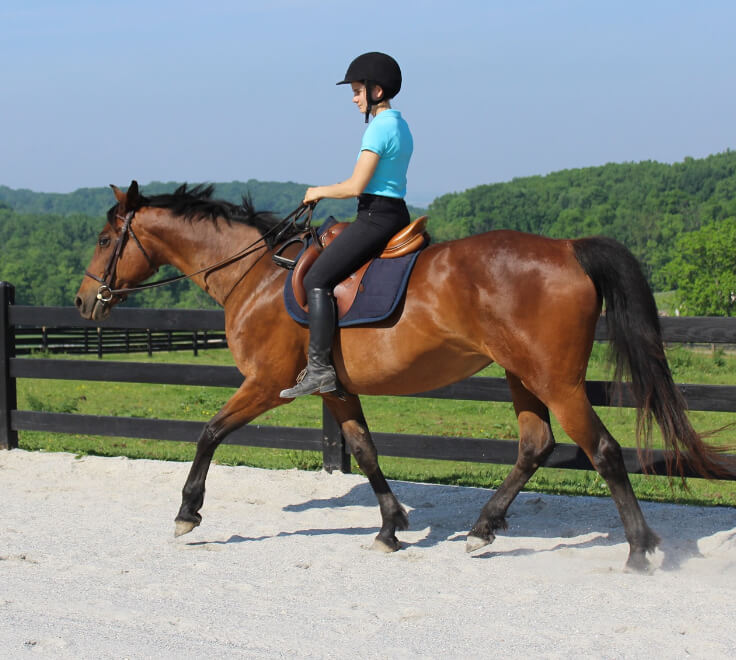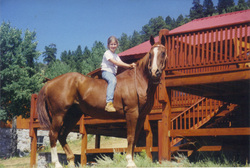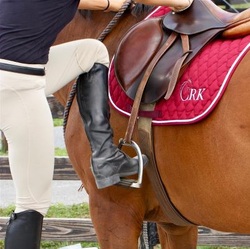“Heels down!” May be the most common advice given to riders in all disciplines, but just how important is this part of our riding posture?
While I do agree that the lower leg ankle and heel play a big role in our stability and the effectiveness of our riding aids, I believe that there are a few distinctions not explained in the phrase “heels down” that may determine whether that lowered heel helps the rider or negatively affects their balance and comfort riding.
In today’s video we are going to consider three things related to heels down, so hit play to watch the video below.
See you in the comments!
Callie














49 Responses
Heels Down! No wonder I feel off balance sometimes and then tend to squeeze my legs encouraging horse to go faster!! That is not what I want. Thank you for pointing out it is a more individual position and one I can now adjust to a more balanced position.
As a rider of less than 3 years in my late 70’s, ankle flexibility is somewhat compromised so your video tips make my day.
I enjoy your analytic style. Each and every CRK video i watch has given me some insight. I’ve heard “heels down” multiple times in my one year of riding. I’ve interpreted it just as you described even though i could not put words to the sensation as nicely as you do. I do have restrictions in one ankle, so your method gives me awareness to accommodate and work within my limits. I’m an older rider and the physicality can be a challenge.
Wow! Thank you so much for this video tutorial. In 4 years of riding lessons from around 12 different instructors, I heard this ad nauseum ..and still do from my present instructor . They also add the exercises I can do to gain more elasticity which I’ve been doing for many years to strengthen weak ankles. You definitely pegged the side effects too: stiff leg muscles and being out of alignment. It helps to have all of this confirmed. Now to convince my instructor..:)
Tuesday I visited the orthopedist because of discomfort and swelling in both Achilles Tendons… yes, a partial tear …. I used my ‘heels down with pressure’ for months as I thought that would ‘save me’ from an errant spook … I decided that I wasn’t going to stop riding until the tendons healed so the next day I rode with only weight, no pressure, and my horse spooked… guess what I remained stuck to her with my long wrapped leg following the spook . my mare responding to my weight stopped. This validated for me that ‘heels down’ was not the answer to remaining adhered to the saddle…. It is the relaxed leg from groin down that does NOT pinch.
Maybe someone has a descriptive word for the ‘wrapped ‘ leg… Even though this is what it does feel like it took me years to understand/feel the most important component” no pinching anywhere!
Well put, Diane, I think “wrapped” leg is a great way to describe the feeling.
I hear it all the time. Each time I had to put my heels down, my feet would feel awkward & my ankle would hurt.
I love watching your videos. You have such an easy way of explaining methods that make them easy to understand. Thank you!
Thanks Mischel!
This is very helpful instruction – I’m just learning the English style of riding & my instructor provides so much specific instruction on various body parts – it’s confusing. I’ve noticed lately that if I sit up straighter (as suggested in the video) she seems happier with my heel position, (& it feels more natural to me.) thanks!
Flexibility in the ankle is so often overlooked by many instructors. I have found that if you perceive the stirrup as a footrest everything in the leg will fall into place. Thank you, Callie for this video as it has confirmed what I have learned a long time ago. Now we just need instructors to teach it.
Thanks Donna for that great advice! I can see you a ‘foot rest’ perception would help better than trying to force my heels down. I love Callies videos and your comment added to what I got out of this one. Thank you!
So helpful! My instructors have always told me to crank my heels up toward my shin. My last instructor would even say “if it hurts your ankle, you’re doing it right”…
I’m so grateful for for this video, no one has ever explained it so well!
Thanks Rachel, but Ouch! I would certainly avoid pain, specially in joints! Over-stressing a joint can cause a lot of problems down the road.
Makes perfect sense. Thanks for sharing!
Hi Callie,
Can’t thank you enough for sharing your learnings. Have really enjoyed your short video series how to ride better in 7 days. I hope that your video series eventually comes across the computer screens of every rider around the world. Your approach is well thought out and presented.
Hope that you will consider coming to Australia to run a couple of courses. We are in Sydney. Do you have any plans to travel here?
Thanks again, Jo
Hi Jo,
Thanks for your comment, glad you enjoyed the course! I honestly don’t travel very much to teach at the moment, but Australia is a place I would LOVE to visit! If you know of a place that may be interested in hosting a class I’d love to discuss it!
Callie hello,
I think you’re right, the sentence “heels down, is too general”, I remember one day I told my instructor that each person has their own elasticity and at that, little can be done except try to get more elasticity doing exercises designed to get the goal we all want.
Thank you for your tips. It’s a shame that we are so far apart. I’m in Spain and I can not attend your classes as I want it
Ramon
Hi Ramon,
I would love to meet you someday if you ever want to take a vacation to the US!
Hi, I have been riding for 37 lessons and already doing small jump courses, but I think I have heard heels down 49 times. Especially in the beginning, my heels are flat and won’t go down any more than that. Do you know any exercises I could do to strengthen them?
Hi Bella,
The fact that your heel is flat may not be a bad thing – as I mentioned in the video, how low a person’s heel can comfortably stretch down varies quite a bit. I would focus more on exercises to practice an adjustable ankle with your balance on the balls of your feet. A good exercise for this is standing on an unstable surface, like a balance cushion (there is a video on this in the free 7-day riding course), or the edge of a stair. Instead of just trying to stretch your heels down though, practice going in and out of a pretend two point position . This will challenge your balance and you should feel your knees and ankles adjusting to maintain balance. Hope this helps!
Awsome video as always. You explain things in a way that makes so much sense thanks again
Hello everyone and thanks Callie for another great video. I am a beginner and struggling to properly put things together such as sitting deep in the saddle, keeping the heels down (yes, our instructor keeps repeating it) and finding the proper stirrup length. As a matter of fact, I am getting the “footrest feeling”; however, at the same time, I feel like this prevents me from keeping the right posture (sit deep in the saddle). Any advice? Thanks again
If you have the opportunity, I would recommend doing some riding without the stirrups. This will help you find the most balanced position for your seat as your body will go there more easily on its own without the stirrups to press against. The stirrup length depends on what you are doing, but generally when I adjust stirrups for riders who are just starting out I keep them long enough that they can keep much of the same feeling they had when they were riding without the stirrups. Also, your instructor may be correct in asking for “heels down” depending on your position, but I prefer to call it “lengthening the lower leg” – I feel this creates more of a long leg, tall body position instead of “heels down” creating a more braced position.
Thanks for explaining an important topic. Those of us that have spent 20 years in 3″ heels can no longer lower our heels without stiffening the entire leg. It’s good to recognize that a level foot can have the same function as a low heel, depending on the rider’s flexibility.
I could never get comfortable in the saddle with heels down. I felt off balance and awkward. Over time, I’ve learned that I have a very good seat without that added pressure to the heal. Thanks for clearing all this up, Callie. 🙂
** heel ** lol – can’t spell 🙂
Thanks for this video, Callie. All I hear is “heels down”, “leg back”. My biggest issue is that my legs want to come forward and up when I am trotting, so I have a problem keeping my feet in the stirrups. Your video makes a lot of sense and I will try to put it to practice.
Hi Ginny, Thanks for your comment! The next time you are trotting, think “knees forward and down”, especially when you post. This will help keep your lower leg under you but without trying to pull it back using only your hamstring.
Great topic for exploration and fabulous video. I like the footrest idea too thanks Donna. I try …try….to focus more on feeling that feet are connected to the ground in the manner of skis going over bumpy ground: smooth, responsive, flexible, light, lightly resting. Although I don’t worry too much about this, I think of allowing toes up vs thinking heels down. I more often remind myself heels out as I have a tendency to use my heels to aid from incorrect early learning. Thinking of connecting my feet to the ground surface is a sort of first safety measure too if things get a bit hairy. Legs down, feet level and out, seat strong etc.. Love it Sandra that you are learning in your 70’s, inspirational. Thanks Callie.
Great visuals here, Suzanne – thanks!
This makes me feel so much better about the whole ‘heels down’ thing. I was a runner for most of my life and I have really tight tendons and muscles, despite doing stretching exercises. I have tried everything to get my heels as low as possible, including just standing on the edge of a stair and letting them drop. But guess what? After 20+ years of running, they are just tight, so the most I can accomplish is a level foot. So there! The point is as long as I feel balanced, what difference does it make if my foot isn’t almost vertical!
Glad you enjoyed the video, Karen!
Great post!!
One item that would be helpful for me (and perhaps other less experienced riders) is how to avoid getting light in the stirrups during transitions. It happens to me when I’m asking for a canter (usually the off-side foot) and sometimes results in me trying to get my boot back into position while I’m setting-up for a jump. And that can cause confusion for both of us.
Any suggestions would be really appreciated.
Jack
Hi Jack,
Thanks for the suggestion – I will give this one some thought and see if I can put together a video on it!
Hi,
Jack’s comments are exactly what I’m going through as well – when I’m transitioning, my ankles get loose and I lose contact with my horse . I’m in my 50’s and a beginner with about 5 months under my belt. I’m quite flexible in the lower leg, with heels down, but strength to keep close contact ‘wrapping’ around the horse seems to come & go… maybe some strengthening exercises are in order??
Love to videos….
Michelle
Hi Callie,
I live in Australia and I really want to attend your classes. I have heard heels down every time I go horse riding. This cleared everything up and I hope the riding instructors that say heels down will watch this.
Jade
Hi Jade, I am so glad you enjoyed this one! Would love to have you attend a class, that would be a long trip from Austraila though! I do offer online courses, we just started one but I will offer it again in the Spring and perhaps that would be a good fit for you.
Miss good afternoon.
With great pleasure I write to congratulate each and every one of his videos, which taught me a lot and I am certain that done with love.
With all due respect I want to offer my admiration for what you are, and I dare say that you are a pretty girl.
You show your videos extensive knowledge in both his voice and his expressions I rejoice much, which are cute, you offer a lot of candor, offers much respect.
I hereby want to ask when you perform intensive clinics, ie lasting two, three or more weeks ?. I mention this because I believe that the best education is lived with horses on a daily basis is not the same; reach, clean the horse, saddle, ride and save your stable that; get up at dawn dawned review how the horse, clean his stables, feeding, cleaning saddles, bridles clean, brush, ride, walk him, bathe and keep it in your stable and rest to begin another beautiful day, this makes us more sensitive and mostly wise for better management of our horses.
Nothing is everything and more that remains for me to quote an Arab proverb, “You will be a source of pride and wealth to man.”
I leave you wishing you have a nice weekend and that you retain good
of health.
P.S. I hope you have scheduled date for pesonalizados courses.
Best regards
Rogelio Monroy
Thank you Callie for a superb resource for riders of all levels. I have been riding for a few years in the UK and New Zealand with many different instructors. I can honestly say that you have a distinctly lucid and rational way of instruction. You are a natural teacher ! Like Jack, I have problems stabilizing my lower leg in transitions . Looking forward to any advice you post on this .
Kind regards from NZ !
Z
hello! I’m Samantha! I’ve been riding sense I was 4 years old I’m now graduating from high school and I’ve done IEA For 2 years now. In team practice we’re always being told “Heels Down”. I find it somewhat constricting when I know my heel is already flexible and in a relaxed, supple position to where I can still engage in my riding correctly. I feel some of the girls on our team actually tend to push their heels so far down that their leg slips out in front of them. I sometimes ignore when my coach tells me to put my heels down because it does become painful I remember one lesson I road a very bouncy thoroughbred sweetest horse ever but to jab my heels way, way down actually caused my legs to feel as if they were on fire which by the time our lessons were half way through, my legs felt like jelly. So, now I hold to my preferred length, I always score high in my Equitation classes so I don’t see what is with the huge fascination in jabbing your heels so far down when you already know they’re down and that they are in a comfortable position?
I did recommend you’re YouTube Channel to our IEA team and on our farms Website and added referrals onto the facebook page of our barn as well. Sometimes I have a lot of questions about why and how most basics actually are used for. Including body positioning, because that is the first thing you learn when you ride (I would hope), is that you have a strong upper body and leg position and why it is the way it is. Not a lot of coaches were able to describe to me and make due that I understood! I am a very questioning student even up until this very day! I like to know a lot I want to know a lot and learn much, much more! Thanks for all of your help Callie!
Thanks Samantha! I really appreciate that you shared my website!
Hello I’m a new rider. All weekend all I heard was “heels down.” I much prefer Callie’s advice to think of it as directing”weight” not “pressure” into the heel. I discovered the unspecific heel’s down mantra left me with rather sore knees.
Another comment: Callie, yours are the most useful, helpful, concise and well produced instructional videos I’ve found. Thank you.
kj
Thank you Katherine – I really appreciate that!
Hello from Poland!
I’m also a new rider like Katherine and I – or maybe rather my instructor- belong to the “heels down club”. I do NOT feel comfortable pushing my heels down, I try to think “toes up” instead but it doesn’t always work. I also often feel overwhelemed by too many instructions at once-heels down, look up, speed up, flexible elbows, lower your hands and…be aware of cantering horses around you – it’s way too much for me.
Callie, I see some people invite you to Australia- would you consider Poland? 🙂 I’d be one of the first students to attend. However, if I ever travel back to the US where I spent some time in New Jersey, I will definitely consider paying a visit in PA.
It is exciting to think about traveling around! Poland sounds fun too – haha!
Hello Callie,
I was always told to push my heels down by my riding instructor. It took me close to 10 months but now I think my help position is OK since my instructor points this out less often. Of course I also tried to bring in some flexibility by doing yoga. What I clearly noticed is in the forward seat position, having the heel down brings in much more stability but here I think the heel is down because of the weight and not because of pressure. Since I started cantering a bit, my instructor has again started telling me to keep my heels down since I am losing my stirrup some times.
Yoga is AMAZING for riders. Balance, lengthening, strengthening, stretching – it’s ALL good.
My question to all ( I SO agree that taking a “heels down” approach can create a braced leg & core and stiff posture.) Has anyone ever been told “keep your toes up” in the ring? That one command has really helped me and my new OTTB stay calm & evenly distributed in the saddle. I heard this from one trainer years ago and have never heard it again.
Does this apply for jumping and shorter stirrups?